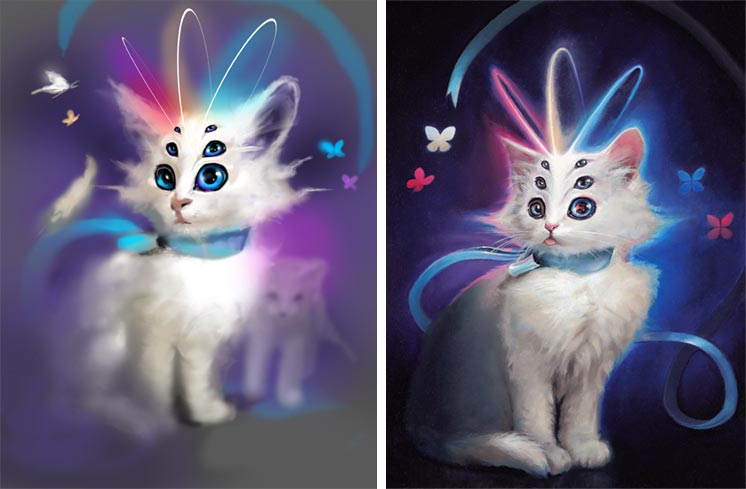A friend recently asked:
“So do you make thumbnails and sketches digitally? How does that translate to your work when it’s in traditional media? And if you’re doing this digital sketch already, why not complete it all on the computer and then print that out on canvas?”
I use both digital painting and traditional pencil and paper for studies. Creating digitally painted studies allows me to plan color and composition quickly and to establish the initial idea for a painting. So I get that stuff nailed down using a Wacom Intuos3 6 x 8-Inch Pen Tablet and Adobe Photoshop. After making sure it looks decent on my computer, I start painting the full version in oils. While working on an oil painting, I also use the color picker tool in Photoshop to extract colors from my study or reference photos. Extracting colors from an image allows me to isolate and magnify the colors I want to represent. I am partially color blind, and it is sometimes difficult for me to see subtle variations of colors. Therefore, the color picker tool is an enormous help. For this purpose, I also use a color picker app to isolate colors from photos on my iPad; it’s another convenient tool at my studio easel. I can separate a color from a digital reference image and then mix that color on my palette. I consider this an excellent learning tool for “seeing” color. One may not appreciate that a patch of white fur on a cat, for example, is more of a tan color when separated from the context of the reference photo.


Regarding digital vs. traditional painting, I am committed to traditional painting for fine art. In my practice, the traditional painting experience has proven to be more meaningful and fulfilling than the digital art experience. For one, speaking strictly of paintings, the shortcuts and workarounds available in digital art, such as Photoshop layers, the “undo” button, and texture overlays, are not available to traditional painters, forcing them to undergo a more challenging experience: a physical experience. These challenges have provided me with an opportunity for personal and artistic growth and a sense of overcoming and accomplishment that digital painting has not. The trials of physical media comprise the most compelling reason to invest in a traditional art process over a digital one.
Traditional art also remains a more immediate expression of one’s creativity; the artist relies primarily on their physical body as the medium to produce a creative arrangement. In comparison, digital painting adds at least one layer of mediation to the artist’s creative process: a computer interface. The art observer will require a similar mediation layer to witness and enjoy the artist’s digital product. Applying Hakim Bey’s concept of Immediatism to the art-making process, artists may find the extra layers of mediation dull their creative fulfillment. If the purpose of fine art is self-discovery, then a digital painting will tend to be inferior to a traditional painting—at least until “digital” no longer implies dilution through additional layers of media (which may be sooner than we expect). For today, we are physical, not digital, beings first.